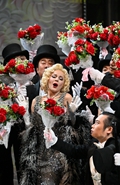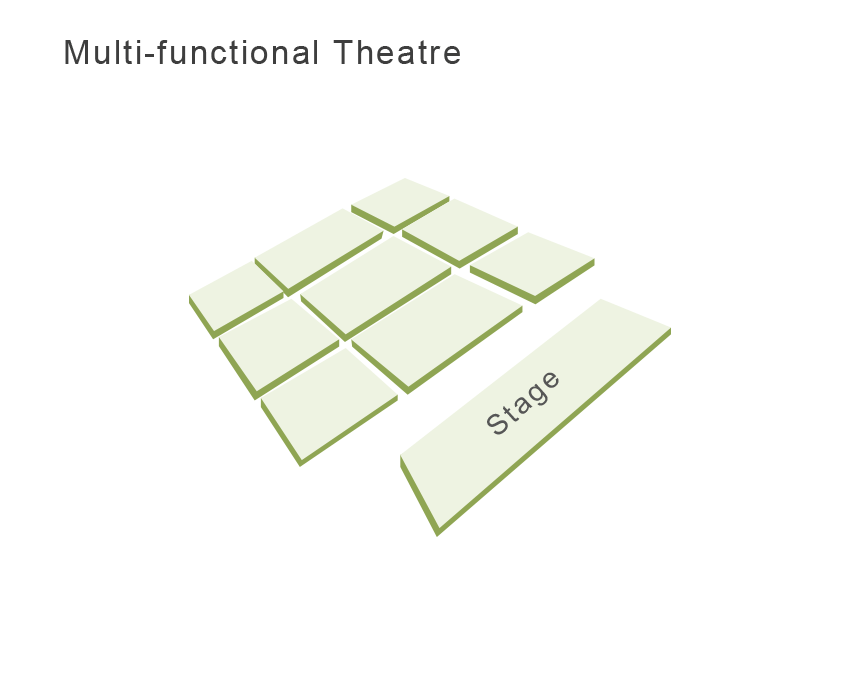Loyal to his reputation as a fairy tale paleoanthropologist, Jean-Christophe Maillot strips
Cendrillon (Cinderella) of its sugar-coated layer and delivers a poignant meditation on the way in which people who disappear shape the future of those left behind. The theme of a prince who marries a peasant girl (an idea responsible for the shattered dreams and hopes of entire generations) is not given a lead role here. The choreographer denies this idea the importance it is usually given, preferring to focus on the emotional cogs that drive this timeless tale forward.
Because in addition to a reflection on mourning, Cinderella is a funny, incisive take on a society crammed full of artifice, where the quest for pleasure strips its inhabitants of any sense of reality. Frenzied distraction rubs shoulders with idleness, and the palace’s Two Superintendents of Pleasure are on-hand to entertain a moribund court slowly suffocating from boredom. Yet again, Jean-Christophe Maillot gives these two key characters movements all of their own. Every step, every jump reflects the over-excitement, one-upmanship and thirst for happiness they seem to mindlessly promote.
In contrast to this, Cendrillon (Cinderella) is simplicity incarnate (a key concept that influenced Ernest Pignon-Ernest’s set design). She needs no accessories to render her beautiful, and even the famous glass slipper is replaced here with a bare foot glistening with delicate, ephemeral gold dust. Cinderella’s bare foot becomes a symbol of ballet. It symbolises not only the simplicity and starkness of this young girl, but also a part of the body without which dance would not exist. The foot is the pivot of choreographic art, its pillar, its momentum, its take-off and its survival.
Somewhere between Cendrillon (Cinderella) and the lying, cheating world she inhabits is the Prince, imprisoned in his palace, brooding as he waits for a more real existence. Having only ever known flattery and emotional repression, he is unaware of the real world. Everything slips between his fingers like sand, he has no memory to hold on to because he has never truly lived. A spectator of his own life, he is suspended between life and the void. His moments of desolation and dejection differ from those experienced by Cendrillon (Cinderella), yet they too hint at a dream of a different life. The Fairy blindfolds him so that he may know love beyond a pretty face, and he is forced to leave his world to seek the one he loves. The young woman’s salvation does not lie in the social status her future husband can offer her: the Prince must abandon his palace and prostrate himself "at the feet" of his loved one. Thus, the lovers embark on a journey hand-in-hand, ready to take on all that the world offers up to them. Death is no longer unbearable. The deceased walk beside them. And they lived happily ever after...
Credits
Choreographer: Jean-Christophe Maillot
Music: Sergei Prokofiev
Set Designer: Ernest Pignon-Ernest
Costume Designer: Jérôme Kaplan
Lighting Designer: Dominique Drillot
Cast
The Fairy: Marianna Barabas (Mar. 14th), April Ball (Mar. 15th), Mimoza Koike (Mar. 16th)
The Father: Matèj Urban (Mar. 14th / 16th), Alvaro Prieto (Mar. 15th)
Cinderella: Alessandra Tognoloni (Mar. 14th / 16th), Anjara Ballesteros (Mar. 15th)
The Prince: Francesco Mariottini (Mar. 14th / 16th), Simone Tribuna (Mar. 15th)
The Stepmother: Mimoza Koike (Mar. 14th), Anna Blackwell (Mar. 15th), Marianna Barabas (Mar. 16th)
The Sisters:
Gaëlle Riou (Mar. 14th / 16th), Anissa Bruley (Mar. 15th)
Anna Blackwell (Mar. 14th), Anne-Laure Seillan (Mar. 15th), Elena Marzano (Mar. 16th)
Prologue
Cinderella, from the depths of her solitude, lets herself be invaded by the memories of her mother and father, the image of a lost family happiness and love. A shared anguish - conjured up from this dream, or actual presence - remains with the child and her father.
Act I
Cinderella, holding in her arms the dress her mother was wearing for her last ball, remains pensive. Her father, in the light of his new family, is not quite the same. Distressed, he hesitates between the desire to protect her and submitting to his new wife. Cinderella, with her stepmother and her stepsisters, discovers the violence of power struggles, rejection, ill will, and tyrannical gestures. A strange messenger comes to put an end to the two sisters' quarrels: she receives an invitation from the Prince to attend the court ball. The pleasure superintendents, beauty experts, are ready to officiate.
The young charming prince appears, in company of his friends, as an adolescent blessed with luck, but a little immature, disappointed not to find what he is desperately missing. A touching character, he tries to give some real meaning to his life by partaiking in small pleasures, which disappoint him as soon as they are satisfied. Both pleasure superintendents are busy with their preparations.
Whimsical characters, the pleasure superintendents are the foremen of the festivities. They bring the ball dresses, exhibited on four mannequins, half-human, half-mechanical figures, half-masked, giving the impression of a fashion show. The sisters and the stepmother took great care in their faces. In their impatience and greed, they rush to grab the dresses, only take half of them and they look at themselves with rapture in front of large distorting mirrors. Cinderella becomes aware of the invitation, but her new family makes fun of her and sends her back to her lentil dish. The sisters and stepmother go to the ball, feeling satisfied.
The fairy tears the young girl from her dirty linen and lentil chore and tells her the story of "Cinderella": the four mannequins and the two pleasure superintendents perform for the amused young girl a caricatured and grotesque "Cinderella". She puts on the modest young girl's dress her mother was wearing at her last ball. Then she carries out the transformation: the young girl's foot comes sequined out of her lentil dish. A magical image, but a warning from the fairy: you have to remain simple. Sequins are fragile, volatile and will lose their wonderful properties if Cinderella forgets this essential quality.
The Fairy prepares Cinderella for her entrance into the world. She lets her glimpse the vision of the horizon towards, which she has to walk: In the background, the young girl attends the scene of a ball of which one cannot say whether it is real or only a dream.
Act II
Both pleasure superintendents arrive at the ball, followed by the fairy, then by the two sisters and stepmother. The Prince makes his entrance, together with his friends. He sits on his throne, and looks at the courtesans' parade, without showing much interest. He does not find what he is looking for. In turn, the stepmother and the daughters begin to try and seduce him. But in vain. Someone announces to the Prince the arrival of a strange person. Fascinated, afraid, the Prince seems to understand that he is about to be delivered a message. The father also looks disturbed: it seems to him, without really believing it, that he recognizes his first wife in the fairy. He looks for the one and the other, going from memory to reality. The Fairy puts a blindfold on the Prince's eyes. Cinderella comes in: her feet walk in by themselves, naked and painted, in the ballroom. Having recovered his eyesight, the Prince, fascinated, kneels before them and discovers love with humility. The pas de deux of the young couple matches the one of the mother and father, united in the same loving surge. A dance of redemption, reconciliation for the father, who seems to find peace at last. Cinderella and the Prince continue dancing together alone.
Cinderella begins to take pleasure in the other courtesans' mirrors. She gets intoxicated by the ambient madness and its codes of seductions. She appropriates its emblems. It is time for the fairy to bring Cinderella back on the right path. At the top of the stairs through which she escapes, her bare foot appears, in the light. The only trace of her being there and an invitation to find her again.
Act III
The pleasure superintendents draw the image of the foot which is being sought. Provided with this sketch, the Prince and his friends travel aimlessly to find the beautiful unknown girl. The Prince discovers the foreign country of the red and yellow Exotics. Although tempted, he still does not recognize the foot he is looking for. Then, the Fairy guides him to Cinderella: it's within himself that he will find her.
The sisters get ready to seduce the Prince. But the feet he discovers underneath the bandages are black and bruised. Cinderella's foot is being unveiled in the purity of its whiteness: the Prince recognizes Cinderella at once.
Rejecting his second wife, the father waltzes with the fairy/mother. Dancing their love again, he accompanies her down to her last breath, until death cancels remorse.
 Repertoire
Repertoire
 Films
Films
 Videos
Videos
 Podcast
Podcast
 China NCPA Orchestra
China NCPA Orchestra
 China NCPA Chorus
China NCPA Chorus
 NCPA Resident Singers
NCPA Resident Singers
 NCPA Drama Ensemble
NCPA Drama Ensemble
 Buildings
Exhibitions
Buildings
Exhibitions
 Opening Hours
Services
Opening Hours
Services
 Western Cuisine
NCPA Café
Arts Gifts
Western Cuisine
NCPA Café
Arts Gifts























 歌剧院
歌剧院
 音乐厅
音乐厅
 戏剧场
戏剧场
 小剧场
小剧场












